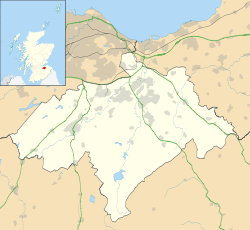Rosewell, Midlothian
Coordinates: 55°51′11″N 3°08′08″W / 55.8530°N 3.1356°W
Rosewell is a former mining village in Midlothian, Scotland, south of Polton and south-west of Bonnyrigg. The village is in the civil parish of Lasswade and was previously a separate ecclesiastical parish,[1] but has its own Community Council, namely Rosewell and District.[2]
The population of the village is 1,566 (in 2011).[3]
History

The colliery village was established by Archibald Hood, mining engineer and entrepreneur, who developed the Whitehill Colliery from 1856, which was located on the south-western edge of the village. [4] He began a new shaft at the colliery in 1878, built railways for the mines (branching from the Peebles Railway) and erected well-designed houses for the miners, and also encouraged the establishment of a Co-operative Retail Society.[5]
In 1890 he amalgamated his company with the mining interests of the Marquess of Lothian (9th marquess, 1833-1900) to form the Lothian Coal Company.[5] The colliery was named after Whitehill House to the east and was also known as Rosewell. On 1 January 1947 the National Coal Board took over the colliery from the Lothian Coal Company, when mines in Britain were nationalised. The colliery had 3 deep shafts and one surface mine. It reached peak production in 1950, but closed in 1961. [6]
Archibald Hood lived at Rosedale in the south of the village, which is now a category B listed building. This is a mid 19th century two storey gabled house,[4] which was later used by the Lothian Coal Company as a house for its managers, in particular his son James Archibald Hood.[7]
The Rosewell Institute, in Carnethie Street, was built for the Lothian Coal Company as a miners' institute in 1917. The Institute was built on an impressive scale with finely detailed sandstone features.[8]
The Church in Rosewell was built 1871-72 and opened for worship 1874, when Rosewell became a separate ecclesiastical parish. The population of this new quoad sacra parish was recorded as 1,394 in 1881.[1] It was re-united with Lasswade in 2008.[9]
Rosewell was served by a railway station lying between Rosewell and Hawthornden. The station opened in 1855 under the name Hawthornden, but was renamed Rosewell and Hawthornden in 1928. It was served by the Peebles Railway, a branch line of the Waverley Line. Services ran from Peebles to Waverley Station in Edinburgh. The station wwas closed in 1962 but the line remained in use for goods traffic until 1967, although the colliery had already closed by then. [10]
Schools
Rosewell has two primary schools, namely Rosewell Primary School and St Matthew's (Catholic) Primary School. The village is in the catchment area for Lasswade High School, and St David's Catholic High School.
Transport
Rosewell is well served by buses, mainly by route 49, though the service has recently been reduced despite a petition to Lothian Buses (and some route 31) services of Lothian Buses. There is also a small and local private hire company.
For walkers the Penicuik–Dalkeith Walkway passes close by.
Churches
The village has two churches, namely Rosewell Parish Church (Church of Scotland) and St Matthew's Catholic Church.
Since 2008 Rosewell Parish Church has been formally united with Lasswade Church, forming Lasswade and Rosewell Parish Church (with a single minister and Kirk Session, although retaining both places of worship).
Whitehill House
Situated half a mile south-east of the village, Whitehill House is a Tudor-revival building designed by David Bryce and William Burn; according to the Gazeteer for Scotland, it was built in 1844 as a home for Wardlaw Ramsay, proprietor of the nearby Whitehill Colliery (which was later acquired by the engineer Archibald Hood).[11] In World War I it was used as a Red Cross hospital.[12] Until the late 1990s, Whitehill House was run by nuns of the Roman Catholic Church as St. Joseph's Hospital for disabled children. It was visited by Pope John Paul II when he came to Scotland in 1982. It is now privately owned and has a 9 hole golf course in its grounds.
Football
Whitehill Welfare F.C. play their home matches at Ferguson Park, Rosewell.
Sources
- 1 2 Gazetteer of Scotland, 2nd edition, by W. Groome, publ. 1896. Article on Rosewell
- ↑ Midlothian council web site https://midlothian.cmis.uk.com/live/CommunityCouncils.aspx - see entries for xRosewell and District. Retrieved April 2016
- ↑ Census of Scotland 2011, Table KS101SC – Usually Resident Population, publ. by National Records of Scotland. Web site http://www.scotlandscensus.gov.uk/ retrieved Oct 2016. See “Standard Outputs”, Table KS101SC, Area type: Settlement
- 1 2 Historic Environment Scotland portal portal.historicenvironment.scot/designation/LB44171 - Retrieved Oct 2016
- 1 2 "Archibald Hood (1823–1902)". erih.net. Retrieved 21 August 2012.
- ↑ Canmore website of Historic Environment Scotland, formerly Royal Commission on the Ancient and Historical Monuments of Scotland (RCAHMS) https://canmore.org.uk/site/132549 - retrieved Nov 2016
- ↑ Scottish Places website - article on James Archibald Hood www.scottish-places.info/people/famousfirst1177.html - Retrieved Oct 2016
- ↑ Historic Environment Scotland portal portal.historicenvironment.scot/designation/LB43642 - Retrieved Oct 2016
- ↑ Lasswade and Rosewell Parish Church web site www.lasswadechurch.co.uk/history.html retrieved April 2016.
- ↑ Disused Stations website www.disused-stations.org.uk/r/rosewell_hawthornden - retrieved Nov 2016
- ↑ "Overview of Whitehill House". Scottish Places.
- ↑ "Who's that girl?". John Gray Centre.
External links
| Wikimedia Commons has media related to Rosewell, Midlothian. |

